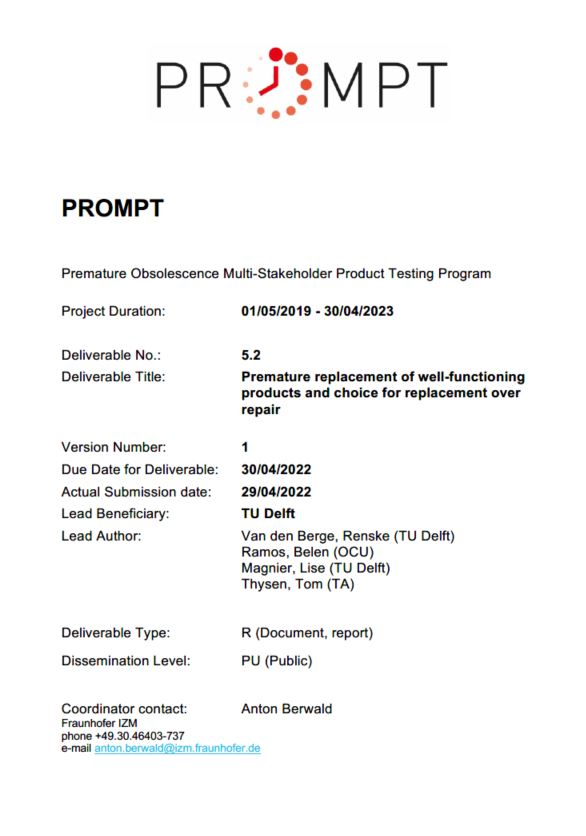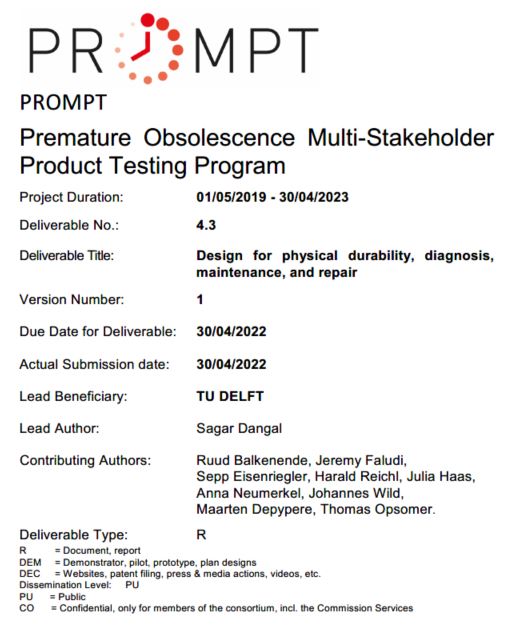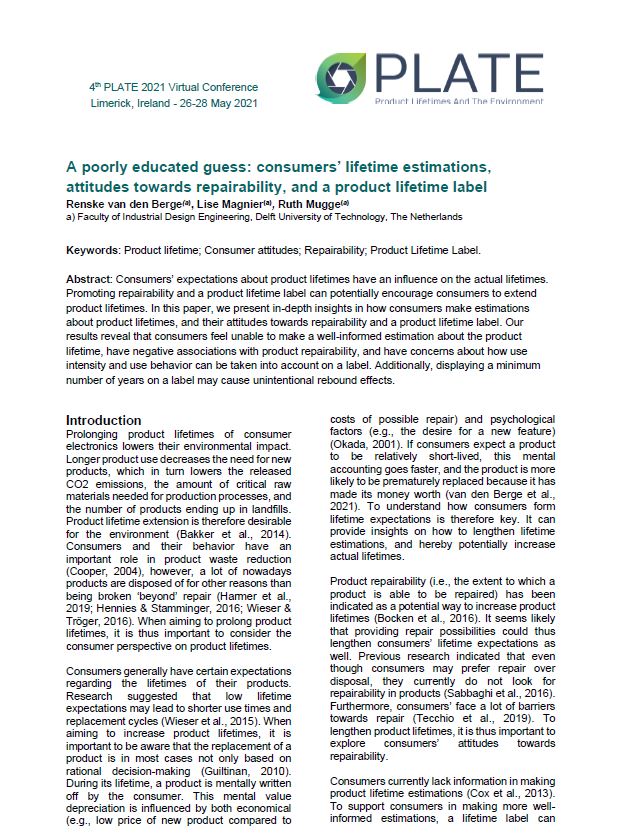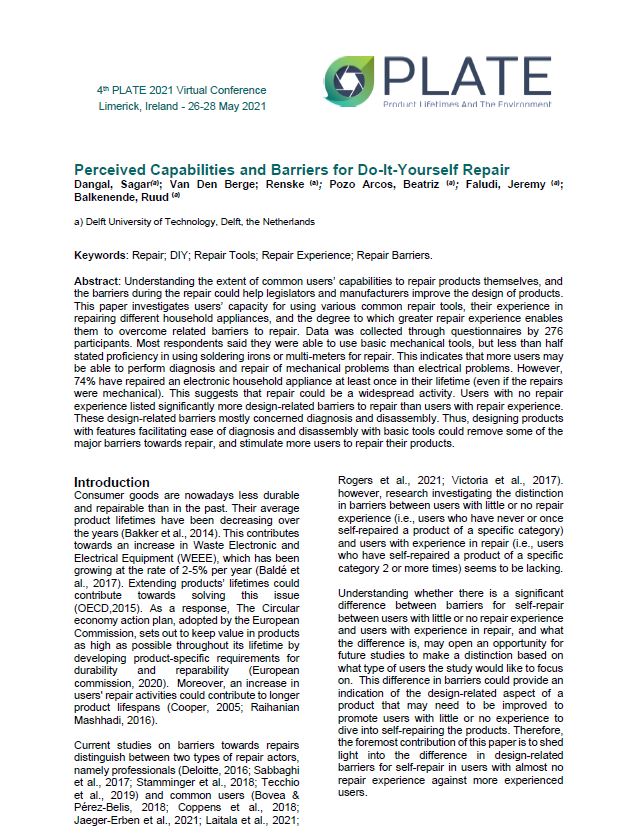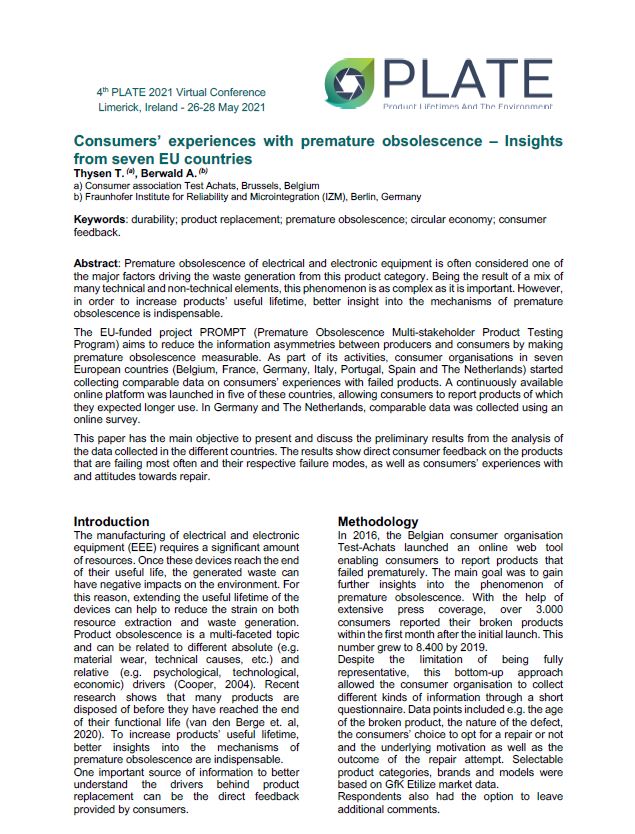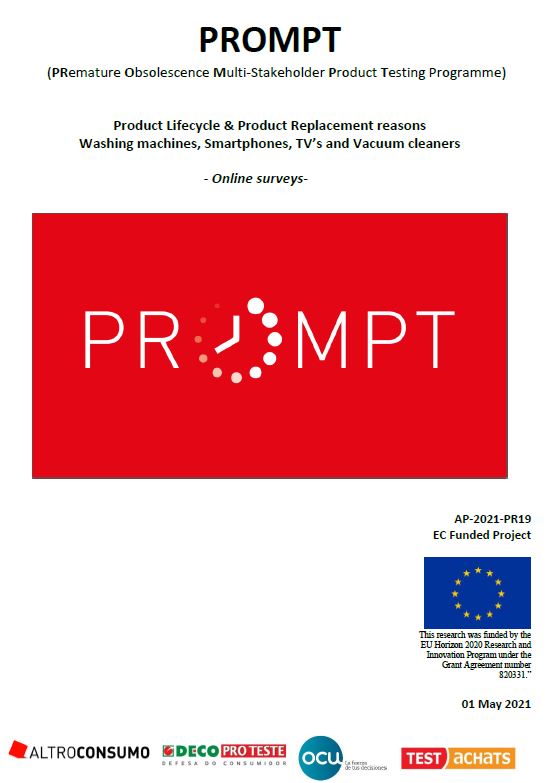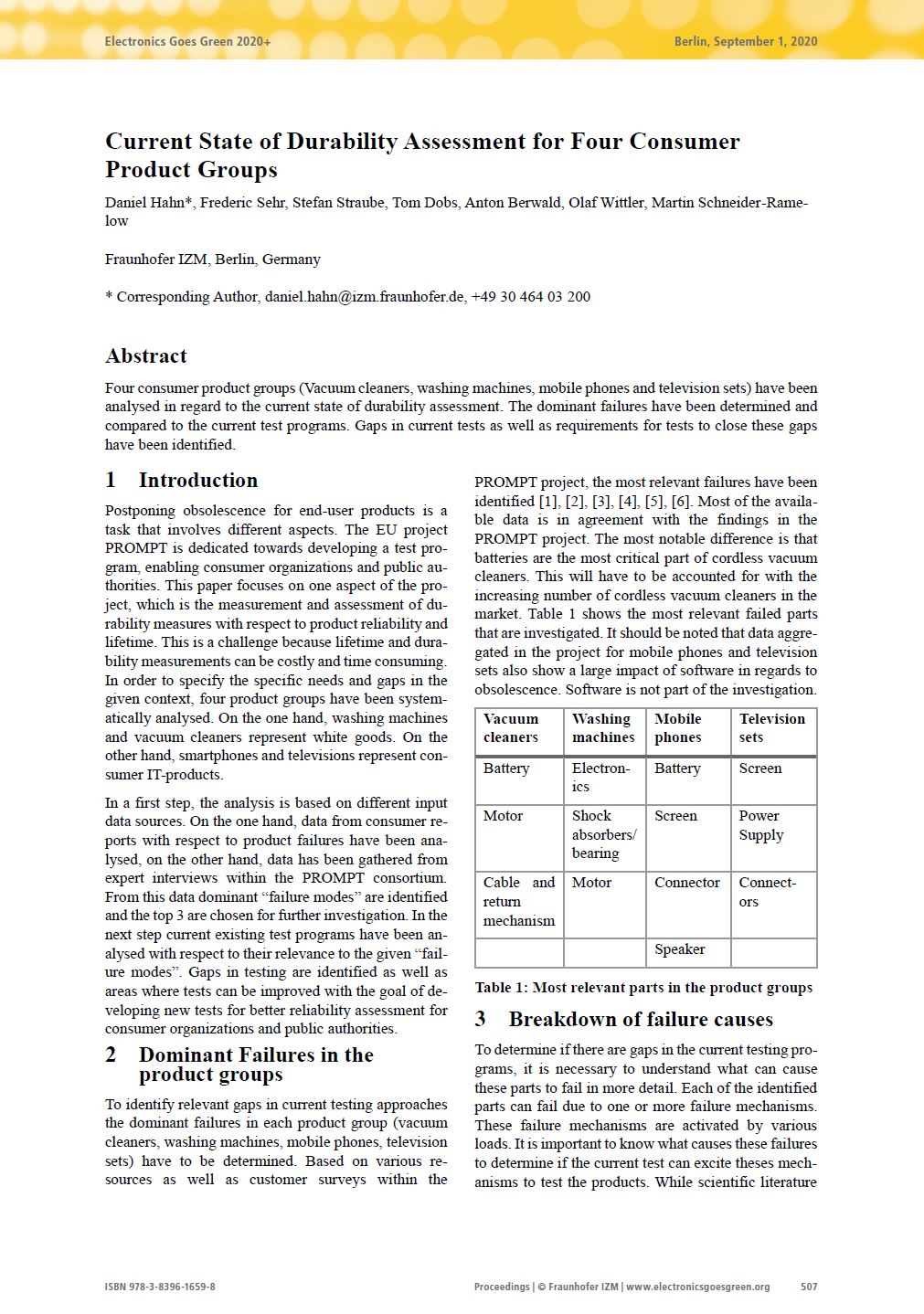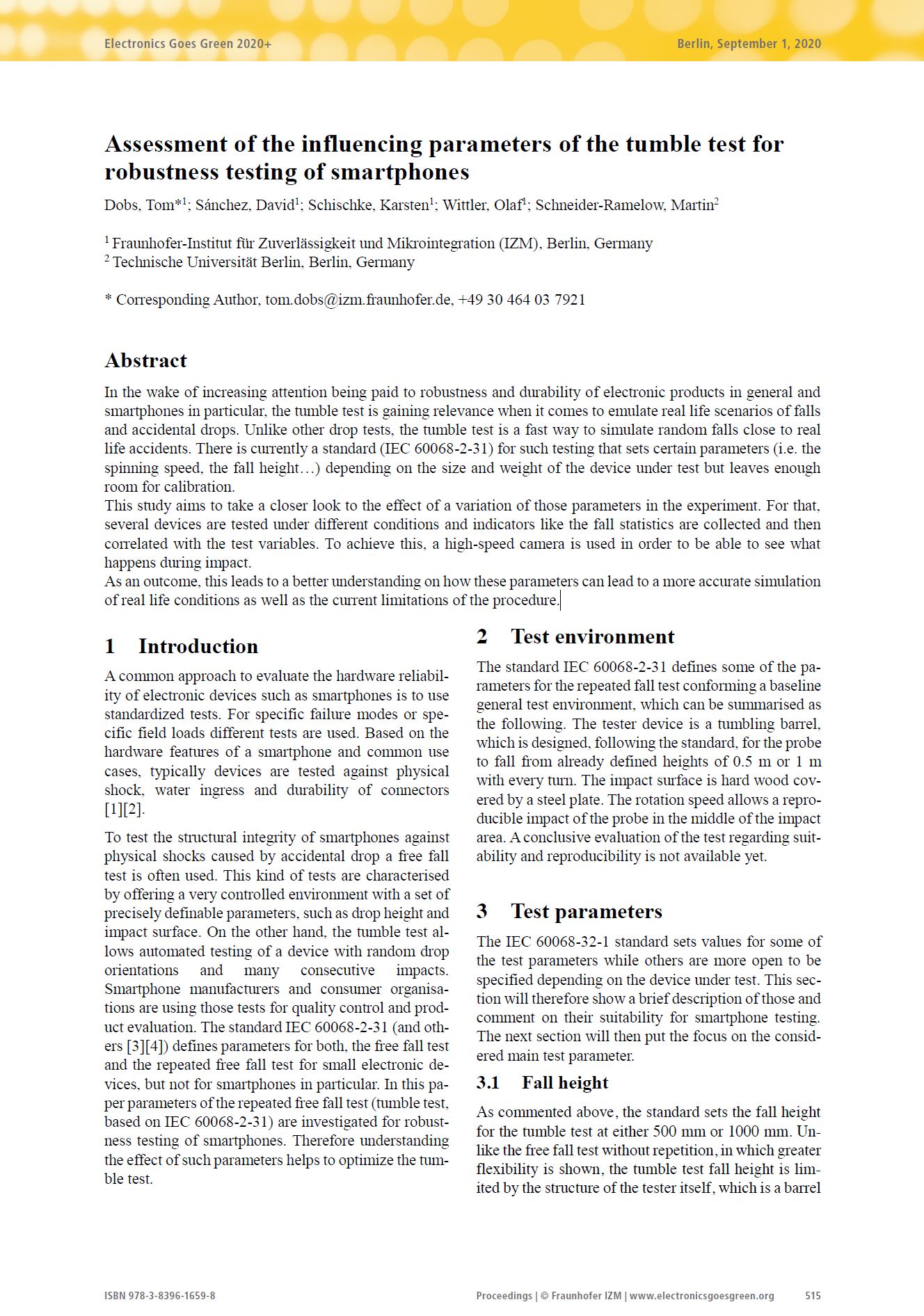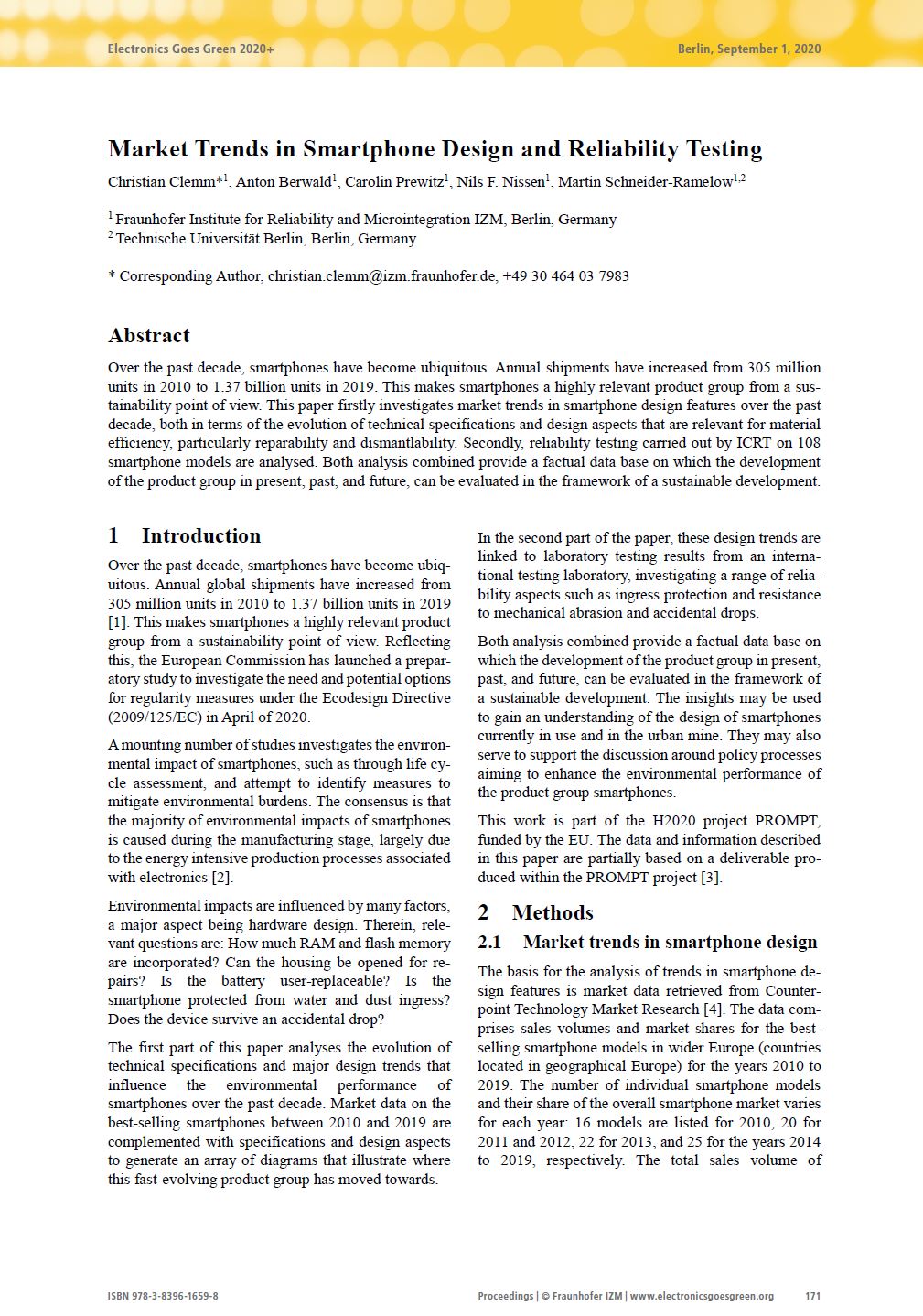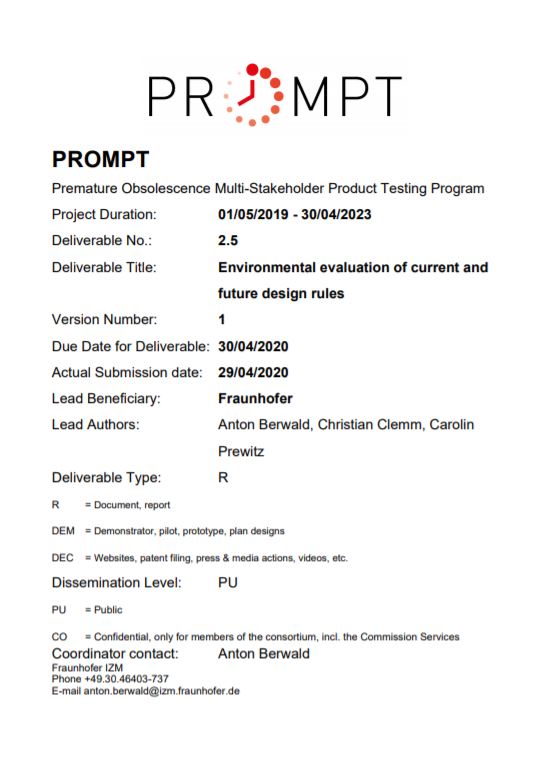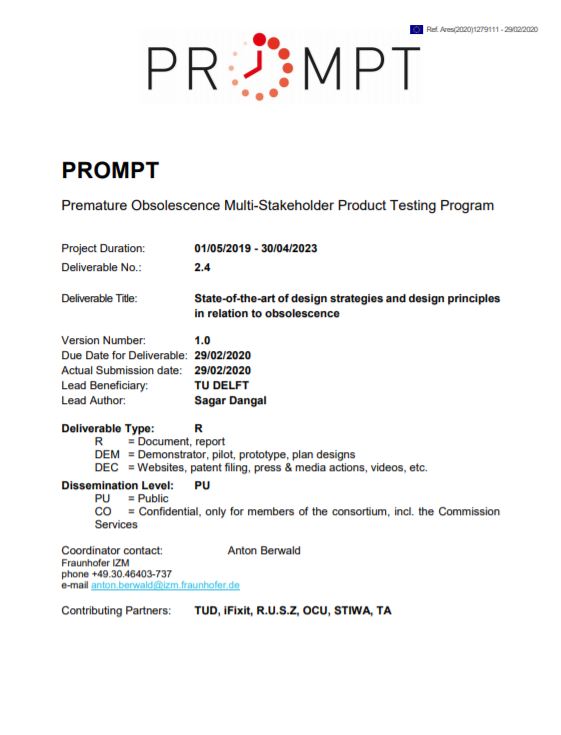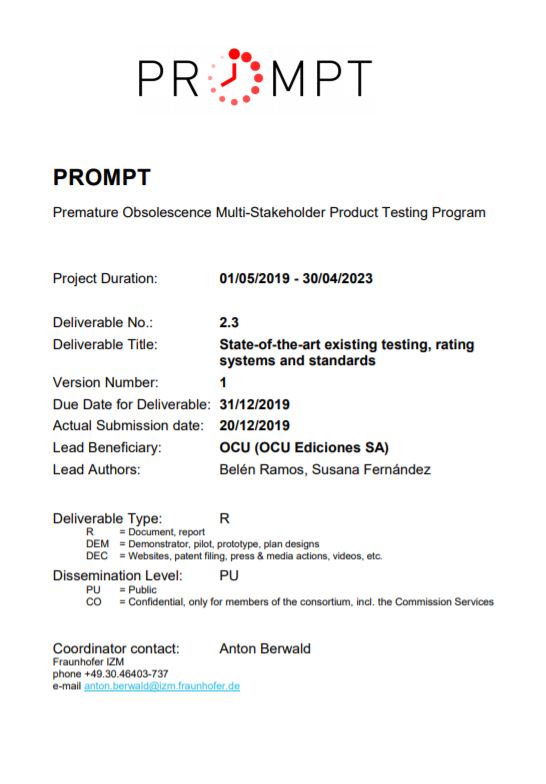Research on premature obsolescence
On this page, you will find results from the PROMPT research on premature obsolescence. Please note, that some of the deliverables still have to undergo an external review as part of the Horizon 2020 process. However, since the topic of premature obsolescence is moving fast, the consortium decided to make the deliverables already available to the public. When citing the work, please also quote the version number of the deliverable.
Lead Partner: TU Delft
Date of the Deliverable: 29/04/2022
We provide insights of consumer studies that were specifically conducted for this deliverable, both qualitative (chapter 2) and quantitative (chapter 3), in which we analysed how a product’s design features and/or business model influence people’s replacement and repair attitudes and behaviours. We end with a conclusion in which we reflect upon all insights obtained and how these contribute to previous PROMPT insights and provide input for future deliverables (Chapter 4); for example, how these insights are useful for the development of the criteria for the testing program to assess the user/market-related factors for premature obsolescence.
Please note, that this is the first version of the deliverable and might be subject to changes after the periodical review as part of the H2020 project process.
Lead Partner: TU Delft
Date of the Deliverable: 30/04/2022
This report presents the research conducted on physical design aspects influencing diagnosis, maintenance, repair, and physical durability of electrical and electronic household products. This is done through analysing repair data, expert interviews, observational user tests and design analysis of products. Based on the key insights obtained, this report presents design principles and design guidelines affecting the diagnosis, maintenance, repair, and physical durability of electrical and electronic household products. The guidelines are intended for designers, manufacturers, and product engineers to design and develop electrical and electronic household appliances that resist and postpone premature obsolescence.
Please note, that this is the first version of the deliverable and might be subject to changes after the periodical review as part of the H2020 project process.
Lead Partner: TU Delft
Paper contribution at PLATE 2021 (26-28/05/2021)
Consumers’ expectations about product lifetimes have an influence on the actual lifetimes. Promoting repairability and a product lifetime label can potentially encourage consumers to extend product lifetimes. In this paper, we present in-depth insights in how consumers make estimations about product lifetimes, and their attitudes towards repairability and a product lifetime label. Our results reveal that consumers feel unable to make a well-informed estimation about the product lifetime, have negative associations with product repairability, and have concerns about how use intensity and use behavior can be taken into account on a label. Additionally, displaying a minimum number of years on a label may cause unintentional rebound effects.
Lead Partner: TU Delft
Paper contribution at PLATE 2021 (26-28/05/2021)
This paper investigates users’ capacity for using various common repair tools, their experience in repairing different household appliances, and the degree to which greater repair experience enables them to overcome related barriers to repair. Data was collected through questionnaires by 276 participants. Most respondents said they were able to use basic mechanical tools, but less than half stated proficiency in using soldering irons or multi-meters for repair. This indicates that more users may be able to perform diagnosis and repair of mechanical problems than electrical problems. However, 74% have repaired an electronic household appliance at least once in their lifetime (even if the repairs were mechanical). This suggests that repair could be a widespread activity. Users with no repair experience listed significantly more design-related barriers to repair than users with repair experience. These design-related barriers mostly concerned diagnosis and disassembly. Thus, designing products with features facilitating ease of diagnosis and disassembly with basic tools could remove some of the major barriers towards repair, and stimulate more users to repair their products.
Lead Partner: Test Achats
Paper contribution at PLATE 2021 (26-28/05/2021)
Consumer organisations in seven European countries (Belgium, France, Germany, Italy, Portugal, Spain and The Netherlands) started collecting comparable data on consumers’ experiences with failed products. A continuously available online platform was launched in five of these countries, allowing consumers to report products of which they expected longer use. In Germany and The Netherlands, comparable data was collected using an online survey. This paper has the main objective to present and discuss the preliminary results from the analysis of the data collected in the different countries. The results show direct consumer feedback on the products that are failing most often and their respective failure modes, as well as consumers’ experiences with and attitudes towards repair.
This report shows results from online surveys in 5 EU countries (Belgium, France, Italy, Portugal and Spain). Owners of four product categories (washing machines, smartphones, TV’s and vacuum cleaners) answered questions about their product lifetime expectations at the moment of buying/getting these products, their reasons for replacing their previous appliances and the lifecycle of their previous appliances.
Lead Partner: Fraunhofer IZM
Paper contribution at the Electronics Goes Green 2020 (01/09/2020)
Four consumer product groups (Vacuum cleaners, washing machines, mobile phones and television sets) have been analysed in regard to the current state of durability assessment. The dominant failures have been determined and compared to the current test programs. Gaps in current tests, as well as requirements for tests to close these gaps, have been identified.
Lead Partner: Fraunhofer IZM
Paper contribution at the Electronics Goes Green 2020 (01/09/2020)
In the wake of increasing attention being paid to robustness and durability of electronic products in general and smartphones in particular, the tumble test is gaining relevance when it comes to emulating real-life scenarios of falls and accidental drops. Unlike other drop tests, the tumble test is a fast way to simulate random falls close to real-life accidents. There is currently a standard (IEC 60068-2-31) for such testing that sets certain parameters (i.e. the spinning speed, the fall height…) depending on the size and weight of the device under test but leaves enough room for calibration.
This paper aims to take a closer look at the effect of a variation of those parameters in the experiment. For this purpose, several devices are tested under different conditions and indicators like the fall statistics are collected and then correlated with the test variables. A high-speed camera is used in order to see what happens during the impact. The results provide a better understanding of how these parameters can lead to a more accurate simulation of real-life conditions as well as the current limitations of the procedure.
Lead Partner: Fraunhofer IZM
Paper contribution at the Electronics Goes Green 2020 (01/09/2020)
Over the past decade, smartphones have become ubiquitous. Annual shipments have increased from 305 million units in 2010 to 1.37 billion units in 2019. This makes smartphones a highly relevant product group from a sustainability point of view. This paper firstly investigates market trends in smartphone design features over the past decade, both in terms of the evolution of technical specifications and design aspects that are relevant for material efficiency, particularly reparability and dismantlability. Secondly, reliability testing carried out by ICRT on 108 smartphone models is analysed. Both analyses combined provide a factual data base on which the development of the product group in present, past, and future, can be evaluated in the framework of sustainable development.
D.2.6: State-of-the-art knowledge on user, market and legal issues related to premature obsolescence
Lead Partner: TU Delft
Date of the Deliverable: 30/04/2020
This deliverable provides an overview of the state-of-the-art knowledge on reasons to replace products addressing user, market and legal aspects. The data used for this report is from both scientific literature and reports from consumer associations. The report shows an overview of (scientific) literature and gives insights from consumer studies related to the user and market issues of premature obsolescence. The literature study consists of two parts. The first part covers a general overview of the different types of (premature) product obsolescence that exist and the general reasons why people replace their products. The second part provides information on the average lifetime, expected lifetime, replacement motivations, barriers towards repair activities, national differences in repair activities and possibilities for lifetime extension. The last chapter provides an analysis of existing legal provisions on guarantee and repair for elements that might be promoting or hampering products to be repaired.
Please note, that this is the first version of the deliverable and might be subject to changes after the periodical review as part of the H2020 project process.
Lead Partner: Fraunhofer IZM
Date of the Deliverable: 29/04/2020
Thie deliverable “Environmental evaluation of current and future design rules” has three main objectives. First, in the context of the global market situation, it identifies current and future design trends for selected product groups and discusses their environmental impact. Second, it shows a comparison of different existing life cycle analyses (LCA) in order to identify hot spots that are most relevant from an environmental point of view, with a focus on resource efficiency and possible lifetime extension. Third, it analyses environmental break-even points identified in the literature and discusses the advantage of possible lifetime extension.
Please note, that this is the first version of the deliverable and might be subject to changes after the periodical review as part of the H2020 project process.
Lead Partner: TU Delft
Date of the Deliverable: 29/02/2020
This deliverable presents an overview of design strategies, design principles and design features in relation to obsolescence based on literature and state-of-the-art in repair practice. The results presented are preliminary in the sense that they are the result of an initial exploration in a broad field to extract the information most promising for further research in future deliverables of PROMPT. It provides an overview of barriers, various scoring systems, and reports from partners in order to extract design features facilitating and hampering longevity of products. Finally, using these results, an inventory of design strategies and principles, and its relation to different design features are generated and analysed. This inventory will be elaborated and built upon for the development of tests on design aspects in future deliverables of PROMPT.
Please note, that this is the first version of the deliverable and might be subject to changes after the periodical review as part of the H2020 project process.
Lead Partner: OCU
Date of the Deliverable: 20/12/2019
The deliverable “State-of-the-art existing testing, rating systems and standards” summarizes existing information regarding tests, rating systems and standards in so far as they include relevant aspects concerning premature obsolescence for products within the scope of the PROMPT project. It points to existing features and issues that dominate product obsolescence (such as bearing failure, high repair cost and commonly used protocols). In addition, it provides examples, references and background information for future work, reports or dissemination campaigns.
Please note that the current version of the report is not final since it is a “living document” that will be updated throughout the study. If you have any comments or suggestions that should be added to the report, please contact us at info@prompt-project.eu.

